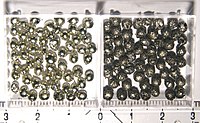
Photo from wikipedia
Abstract The Tengchong–Lianghe tin belt in western Yunnan Province, southwest China, is the most important tin mineralization belt in the Sanjiang Tethyan Metallogenic Domain (STMD). There are two large tin… Click to show full abstract
Abstract The Tengchong–Lianghe tin belt in western Yunnan Province, southwest China, is the most important tin mineralization belt in the Sanjiang Tethyan Metallogenic Domain (STMD). There are two large tin deposits in this belt: the Paleogene Lailishan and the Late Cretaceous Xiaolonghe deposits. The two deposits are spatially and temporally associated with the Lailishan and Xiaolonghe granitic plutons, respectively. Recent studies suggest that the Lailishan and Xiaolonghe granitic plutons exhibit most of the mineralogical and geochemical characteristics of A-type granites. In this study, we discuss the He, Ar, and S isotopes of pyrite samples from the two large tin deposits to trace ore-forming fluids and elements. We also review the relationship between A-type granites and tin deposits from a new perspective. The δ34SCDT values of the Lailishan tin deposit range from +4.9‰ to +6.7‰, with an average value of +5.53‰. The δ34SCDT values of the Xiaolonghe tin deposit range from +5.0‰ to +8.1‰, with an average value of +6.33‰. These values are slightly higher than those of the granites (0‰ to +5.7‰) in the Tengchong–Lianghe area, indicating mainly magmatic sources for the sulfur of ore-forming fluids with a small amount of S from the wall rocks. The Lailishan tin deposit has 3He/4He values of 1.57–3.46 Ra, with an average value of 2.078 Ra, and 40Ar/36Ar values of 382.00–622.99, with an average value of 459.67. The Xiaolonghe tin deposit has 3He/4He values of 0.53–0.88 Ra, with an average value of 0.686 Ra, and 40Ar/36Ar values of 301.06–348.43, with an average value of 322.04. These values suggest that ore-forming fluids of the Lailishan and Xiaolonghe tin deposits have mixed crustal, mantle, and a small volume of meteoric water sources in different proportions. The mantle 4He values and 3He/4He values of the Lailihsan tin deposit (26–44%, 1.57–3.46 Ra) are markedly higher than those of the Xiaolonghe tin deposit (8–15%, 0.53–0.88 Ra), implying increased crust–mantle interaction in the Paleogene relative to the Late Cretaceous in western Yunnan. This interaction may be attributed to the upwelling of the asthenosphere through the break-off of the Neo-Tethyan slab during the main collisional period (65–41 Ma) of India–Asia.
Journal Title: Ore Geology Reviews
Year Published: 2018
Link to full text (if available)
Share on Social Media: Sign Up to like & get
recommendations!